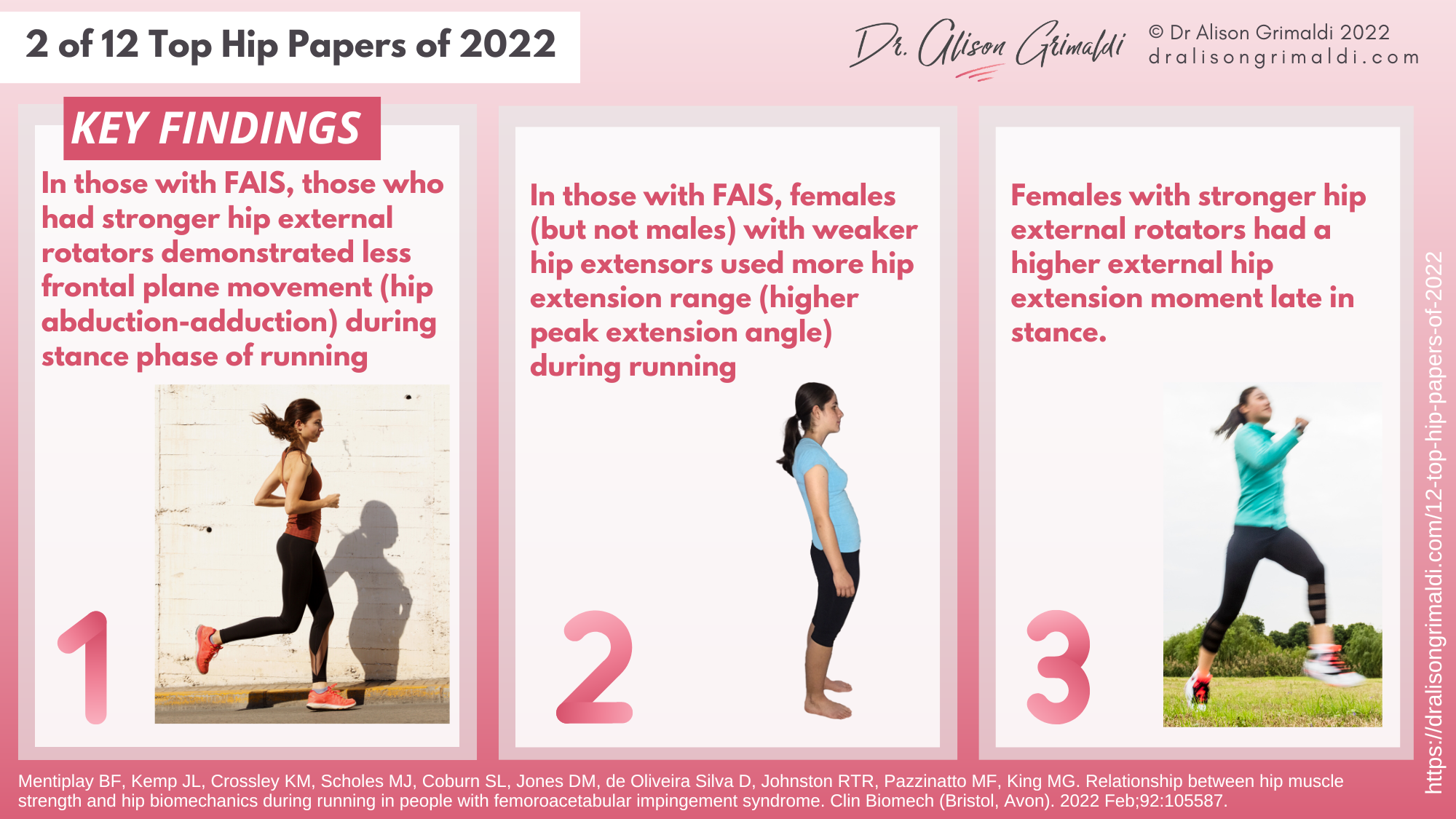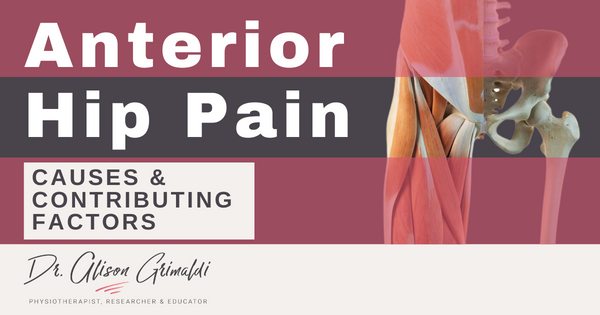2 of 12 Top Hip Papers of 2022 – Running biomechanics in FAIS

Welcome to day 2 of my 12 Top Hip Papers of 2022 miniblog series. On day 2, we are going to take a look at a new paper this year that provided further information about the relationships between muscle strength and running biomechanics in FAIS (Femoroacetabular Impingement Syndrome).

2 of 12 Top Hip Papers of 2022: Relationship between hip muscle strength and hip biomechanics during running in people with femoroacetabular impingement syndrome
There is ongoing debate about the relevance of hip muscle strength to gait biomechanics. This new hip paper, published in February 2022, was one from the LaTrobe team in Melbourne, Australia, where they investigated the relationship between hip muscle strength and running biomechanics in FAIS.
Study Aim:
- To explore relationships between hip muscle strength and hip biomechanics during running in people with femoroacetabular impingement syndrome (FAIS), including evaluating sex as an effect-modifier of this relationship.
What was done:
- Cohort: 42 adults with unilateral FAIS (20 females; age 18-50 years; alpha angle ≥60°).
- Assessment of hip muscle strength with hand-held dynamometry.
- Assessment of hip biomechanics during running using 3 dimensional motion capture (Vicon) and a force plate.
- Linear models assessed the relationships between hip strength and hip biomechanics of the symptomatic limb.
Key Findings:
Key Finding 1:
In those with FAIS, those who had stronger hip external rotators demonstrated less frontal plane movement (hip abduction-adduction) during stance phase of running
Note: External rotator strength was measured in prone at 0° hip extension. Abductors contributing to external rotation in this position include: upper gluteus maximus, posterior gluteus medius and minimus, and piriformis.
Key Finding 2:
In those with FAIS, females (but not males) with weaker hip extensors used more hip extension range (higher peak extension angle) during running.
Note: This does not suggest a direct causation. There may be a common associative factor in females who are more likely to function in greater hip extension. Those with 'sway-type' posture often have smaller, weaker gluteus maximus and walk and run with increased hip extension (until their hip becomes too painful).
Key Finding 3:
Females with stronger hip external rotators had a higher external hip extension moment late in stance.
Note: An external moment needs to be balanced by an opposite internal moment. An external extension moment in late stance is balanced by the hip flexors and anterior joint structures .

Clinical Implications:
- It is unclear how these findings relate to symptoms, however this finding supports an approach that considers hip strength in multiple planes in FAIS rehabilitation.
- Range of hip extension used in gait is known to impact substantially on anterior hip loads: more extension = higher loads. Addressing underlying mechanisms may assist in improving strength and optimising mechanics, if relevant to your patient's symptoms.
- Females with stronger external rotators (with better frontal plane control) appear to be better able to control higher anterior joint forces in late stance.
- Strength and control in all 3 planes is important in FAIS rehab
- Females move differently - tailor your rehabilitation to the individual
This research tells us that strength of the posterolateral muscles of the hip (the gluteals, piriformis and deep short rotators) is associated with running biomechanics in FAIS, both the kinematics and kinetics. This lays the foundation for further work on establishing relationships with symptoms and effect of interventions. The findings support an approach that considers femoropelvic joint and muscle function in three dimensions - both in our assessment and rehabilitative exercise. It also builds on previous evidence that has shown that females and males may move differently, and reinforces the need for individualised treatment approaches.
Another great Anterior Hip Pain blog

Anterior Hip Pain: Causes & Contributing Factors
Adequate consideration of individual causes and contributing factors is important for best outcomes.
Like to learn more about assessment and treatment of patients with FAIS?
In this course, you can find detailed information on pathoaetiology, assessment and management of anterior hip pain associated with FAIS and many other conditions. To learn more, take the online course, or join me in a workshop.
This online course is included in Hip Academy and Hip Academy members receive discounts for online workshops.
I hope you enjoyed the infographics and key learnings from Day 2 of my 12 Top Hip Papers of 2022. There are 10 more papers to come, so stay tuned and return to the blog page each day to see what other top papers and infographics I have for you!
If you missed yesterday's Hip Paper, click the link below to catch up!



